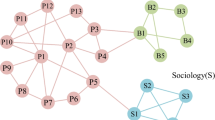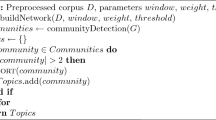Abstract
The community detection in complex networks has become a major field of research. Disjoint community detection deals often with getting a partition of nodes where every node belongs to only one community. However, in social networks, individuals may belong to more than one community such as in co-purchasing field, a co-authorship of scientist papers or anthropological networks. We propose in this paper a method to find overlapping communities from pre-computed disjoint communities obtained by using the core detection label propagation. The algorithm selects candidates nodes for overlapping and uses belonging functions to decide the assignment or not of a candidate node to each of its neighbours communities. we propose and experiment in this paper several belonging functions, all based on the topology of the communities. These belonging functions are either based on global measures which are the density and the clustering coefficient or on average node measures which are the betweenness and the closeness centralities. We expose then a new similarity measure between two covers regarding the overlapping nodes. The goal is to assess the similarity between two covers that overlap several communities. We finally propose a comparative analysis with the literature algorithms.












Similar content being viewed by others
References
Jain AK, Murty MN, Flynn PJ (1999) Data clustering: A review. ACM Comput Surv 31 (3):264–323. [Online]. Available: https://doi.org/10.1145/331499.331504
Fortunato S (2010) Community detection in graphs. Phys Rep 486(3):75–174
Danon L, Duch J, Diaz-Guilera A, Arenas A (2005) Comparing community structure identification. [Online]. Available: https://doi.org/10.1088/1742-5468/2005/09/P09008
Fortunato S, Lancichinetti A (2009) Community detection algorithms: A comparative analysis: Invited presentation, extended abstract. In: Proceedings of the Fourth International ICST Conference on Performance Evaluation Methodologies and Tools, ser. VALUETOOLS ’09. ICST, Brussels, Belgium, Belgium: ICST (Institute for Computer Sciences, Social-Informatics and Telecommunications Engineering). [Online]. Available: http://dl.acm.org/citation.cfm?id=1698822.1698858, pp 27:1–27:2
Yang J, Leskovec J (2012) Structure and overlaps of communities in networks. CoRR. arXiv:1205.6228
Lancichinetti A, Fortunato S, Kertész J (2009) Detecting the overlapping and hierarchical community structure in complex networks. New J Phys 11(3):033015
Attal J-P, Malek M (2015) A new label propagation with dams. In: 2015 IEEE/ACM International conference on advances in social networks analysis and mining (ASONAM). IEEE, pp 1292–1299
Attal J-P, Malek M, Zolghadri M (2016) Overlapping community detection using core label propagation and belonging function. In: International conference on neural information processing. Springer, pp 165–174
Freeman LC (1977) A set of measures of centrality based on betweenness. Sociometry 40:35–41
Bavelas A (1950) Communication patterns in task-oriented groups. J Acoust Soc Am 22(6):725–730
Kelley S (2009) The existence and discovery of overlapping communities in large-scale networks. Ph.D. dissertation, RENSSELAER POLYTECHNIC INSTITUTE
Lancichinetti A, Fortunato S, Kertész J (2009) Detecting the overlapping and hierarchical community structure in complex networks. New J Phys 11(3):033015
Lee C, Reid F, McDaid A, Hurley N (2010) Detecting highly overlapping community structure by greedy clique expansion. In: SNAKDD workshop, pp 4533–42
Reichardt J, Bornholdt S (2006) Statistical mechanics of community detection. Phys Rev E 74(1):016110
Gregory S (2010) Finding overlapping communities in networks by label propagation. New J Phys 12(10):103018
Wang J, Ren J, Li M, Wu F-X (2012) Identification of hierarchical and overlapping functional modules in ppi networks. IEEE Trans Nanobioscience 11(4):386–393
Sales-Pardo M, Guimera R, Moreira AA, Amaral LAN (2007) Extracting the hierarchical organization of complex systems. Proc Natl Acad Sci 104(39):15224–15229
Xie J, Kelley S, Szymanski BK (2013) Overlapping community detection in networks. The state-of-the-art and comparative study. ACM Comput Surv (CSUR) 45(4):43
Hajiabadi M, Zare H, Bobarshad H (2017) IEDC: an integrated approach for overlapping and non-overlapping community detection. Knowl-Based Syst 123:188–199. [Online]. Available: https://doi.org/10.1016/j.knosys.2017.02.018
Huang F, Li X, Zhang S, Zhang J, Chen J, Zhai Z (2017) Overlapping community detection for multimedia social networks. IEEE Trans Multimed 19(8):1881–1893. [Online]. Available: https://doi.org/10.1109/TMM.2017.2692650
Palla G, Derényi I, Farkas I, Vicsek T (2005) Uncovering the overlapping community structure of complex networks in nature and society. Nature 435(7043):814–818
Adamcsek B, Palla G, Farkas IJ, Derényi I, Vicsek T (2006) Cfinder: locating cliques and overlapping modules in biological networks. Bioinformatics 22(8):1021–1023
Shen H, Cheng X, Cai K, Hu M-B (2009) Detect overlapping and hierarchical community structure in networks. Phys A Stat Mech Appl 388(8):1706–1712
Ahn Y-Y, Bagrow J, Jø rgensen S (2010) Link communities reveal multiscale complexity in networks. Nature 466(7307):761–764
Lancichinetti A, Radicchi F, Ramasco JJ, Fortunato S (2011) Finding statistically significant communities in networks. PloS ONE 6(4):e18961
Baumes J, Goldberg M, Magdon-Ismail M, Merkle RC (2005) Efficient identification of overlapping communities. In: Kantor P, Muresan G, Roberts F, Zeng DD, Wang F-Y, Chen H (eds) Intelligence and security informatics. Springer Berlin Heidelberg, Berlin, Heidelberg, pp 27–36
Whang JJ, Gleich DF, Dhillon IS (2016) Overlapping community detection using neighborhood-inflated seed expansion. IEEE Trans Knowl Data Eng 28(5):1272–1284. [Online]. Available: https://doi.org/10.1109/TKDE.2016.2518687
Ma X, Yang P, Guan S (2019) Overlapping community detection algorithm based on edge strength. IEEE Access 7:126642–126650. [Online]. Available: https://doi.org/10.1109/ACCESS.2019.2938783https://doi.org/10.1109/ACCESS.2019.2938783
Xu Y, Xu H, Zhang D, Zhang Y (2016) Finding overlapping community from social networks based on community forest model. Knowl-Based Syst 109:238–255. [Online]. Available: https://doi.org/10.1016/j.knosys.2016.07.007
Wang X, Liu G, Li J (2017) Overlapping community detection based on structural centrality in complex networks. IEEE Access 5:25258–25269. [Online]. Available: https://doi.org/10.1109/ACCESS.2017.2769484https://doi.org/10.1109/ACCESS.2017.2769484
Gregory S (2010) Fuzzy overlapping communities in networks, CoRR, vol. abs/1010.1523. [Online]. Available: arXiv:1010.1523
Zhang S, Wang R-S, Zhang X-S (2007) Identification of overlapping community structure in complex networks using fuzzy c-means clustering. Phys A Stat Mech Appl 374(1):483–490
Raghavan UN, Albert R, Kumara S (2007) Near linear time algorithm to detect community structures in large-scale networks. Phys Rev E 76(3):036106
Ren W, Yan G, Liao X, Xiao L (2009) Simple probabilistic algorithm for detecting community structure. Phys Rev E 79(3):036111
Wu Z-H, Lin Y-F, Gregory S, Wan H-Y, Tian S-F (2012) Balanced multi-label propagation for overlapping community detection in social networks. J Comput Sci Technol 27(3):468–479
Dai Q, Guo M, Liu Y, Liu X, Chen L (2013) Mlpa: Detecting overlapping communities by multi-label propagation approach. In: 2013 IEEE congress on evolutionary computation (CEC). IEEE, pp 681–688
Wu X, Zhang C (2015) Multi-label propagation for overlapping community detection based on connecting degree. In: Salah AA, Tonta Y, Salah AAA, Sugimoto CR, Al U (eds) Proceedings of the 15th international conference on scientometrics and informetrics, Istanbul, Turkey June 29 - July 3, 2015. ISSI Society
Nepusz T, Petróczi A, Négyessy L, Bazsó F (2008) Fuzzy communities and the concept of bridgeness in complex networks. Phys Rev E 77(1):016107
Gregory S (2007) An algorithm to find overlapping community structure in networks. In: Knowledge discovery in databases: PKDD 2007. Springer, pp 91–102
Girvan M, Newman ME (2002) Community structure in social and biological networks. Proc Natl Acad Sci 99(12):7821–7826
Rees BS, Gallagher KB (2010) Overlapping community detection by collective friendship group inference. In: 2010 International conference on advances in social networks analysis and mining (ASONAM). IEEE, pp 375–379
Kovács IA, Palotai R, Szalay MS, Csermely P (2010) Community landscapes: an integrative approach to determine overlapping network module hierarchy, identify key nodes and predict network dynamics. PloS ONE 5(9):e12528
Jin D, Gabrys B, Dang J (2015) Combined node and link partitions method for finding overlapping communities in complex networks. Sci Rep 5:8600
Wen X, Chen W-N, Lin Y, Gu T, Zhang H, Li Y, Yin Y, Zhang J (2017) A maximal clique based multiobjective evolutionary algorithm for overlapping community detection. IEEE Trans Evol Comput 21(3):363–377
Zhang L, Pan H, Su Y, Zhang X, Niu Y (2017) A mixed representation-based multiobjective evolutionary algorithm for overlapping community detection. IEEE Trans Cybern 47(9):2703–2716
Cheng J, Wu X, Zhou M, Gao S, Huang Z, Liu C (2019) A novel method for detecting new overlapping community in complex evolving networks. IEEE Trans Syst Man Cybern Syst 49(9):1832–1844. [Online]. Available: https://doi.org/10.1109/TSMC.2017.2779138https://doi.org/10.1109/TSMC.2017.2779138
Tran TN, Wehrens R, Buydens LMC (2006) Knn-kernel density-based clustering for high-dimensional multivariate data. Comput Stat Data Anal 51(2):513–525. [Online]. Available: https://doi.org/10.1016/j.csda.2005.10.001
Newman ME, Girvan M (2004) Finding and evaluating community structure in networks. Phys Rev E 69(2):026113
Kannan R, Vempala S, Vetta A (2004) On clusterings: Good, bad and spectral. J ACM (JACM) 51(3):497–515
Seifi M, Junier I, Rouquier J-B, Iskrov S, Guillaume J-L (2013) Stable community cores in complex networks. In: Complex networks. Springer, pp 87–98
Blondel VD, Guillaume J-L, Lambiotte R, Lefebvre E (2008) Fast unfolding of communities in large networks. J Stat Mech Theory Exp 2008(10):P10008
Barabási A-L, Albert R (1999) Emergence of scaling in random networks. Science 286 (5439):509–512
Newman ME (2003) The structure and function of complex networks. SIAM Rev 45(2):167–256
Clauset A, Shalizi CR, Newman ME (2009) Power-law distributions in empirical data. SIAM Rev 51(4):661–703
Watts D, Strogatz S (1998) Collective dynamics of small-world networks. Nature 393:440–442
Freeman LC (1978) Centrality in social networks conceptual clarification. Soc Networks 1 (3):215–239
Nicosia V, Mangioni G, Carchiolo V, Malgeri M (2009) Extending the definition of modularity to directed graphs with overlapping communities. J Stat Mech Theory Exp 2009(03):P03024
Ana L, Jain AK (2003) Robust data clustering. In: Computer Vision and Pattern Recognition, 2003. Proceedings. 2003 IEEE Computer Society Conference on, vol. 2. IEEE, pp II–128
Hubert L, Arabie P (1985) Comparing partitions. J Classif 2(1):193–218
Zachary W (1977) An information flow model for conflict and fission in small groups. J Anthropol Res 33:452–473
Girvan M, Newman MEJ (2002) Community structure in social and biological networks. Proc Natl Acad Sci 99(12):7821–7826
Krebs V (2004) Books about us politics. unpublished, http://www.orgnet.com
Lusseau D, Schneider K, Boisseau OJ, Haase P, Slooten E, Dawson SM (2003) The bottlenose dolphin community of doubtful sound features a large proportion of long-lasting associations. Behav Ecol Sociobiol 54(4):396–405
Newman ME (2006) Finding community structure in networks using the eigenvectors of matrices. Phys Rev E 74(3):036104
Xie J, Szymanski BK, Liu X (2011) Slpa: Uncovering overlapping communities in social networks via a speaker-listener interaction dynamic process. In: 2011 IEEE 11th International Conference on Data mining workshops (ICDMW). IEEE, pp 344–349
Attal J-P, Malek M, Zolghadri M (2019) Parallel and distributed core label propagation with graph coloring. Concurr Computat Pract Exp 31(2):e4355
Author information
Authors and Affiliations
Corresponding author
Additional information
Publisher’s note
Springer Nature remains neutral with regard to jurisdictional claims in published maps and institutional affiliations.
Rights and permissions
About this article
Cite this article
Attal, JP., Malek, M. & Zolghadri, M. Overlapping community detection using core label propagation algorithm and belonging functions. Appl Intell 51, 8067–8087 (2021). https://doi.org/10.1007/s10489-021-02250-4
Accepted:
Published:
Issue Date:
DOI: https://doi.org/10.1007/s10489-021-02250-4




